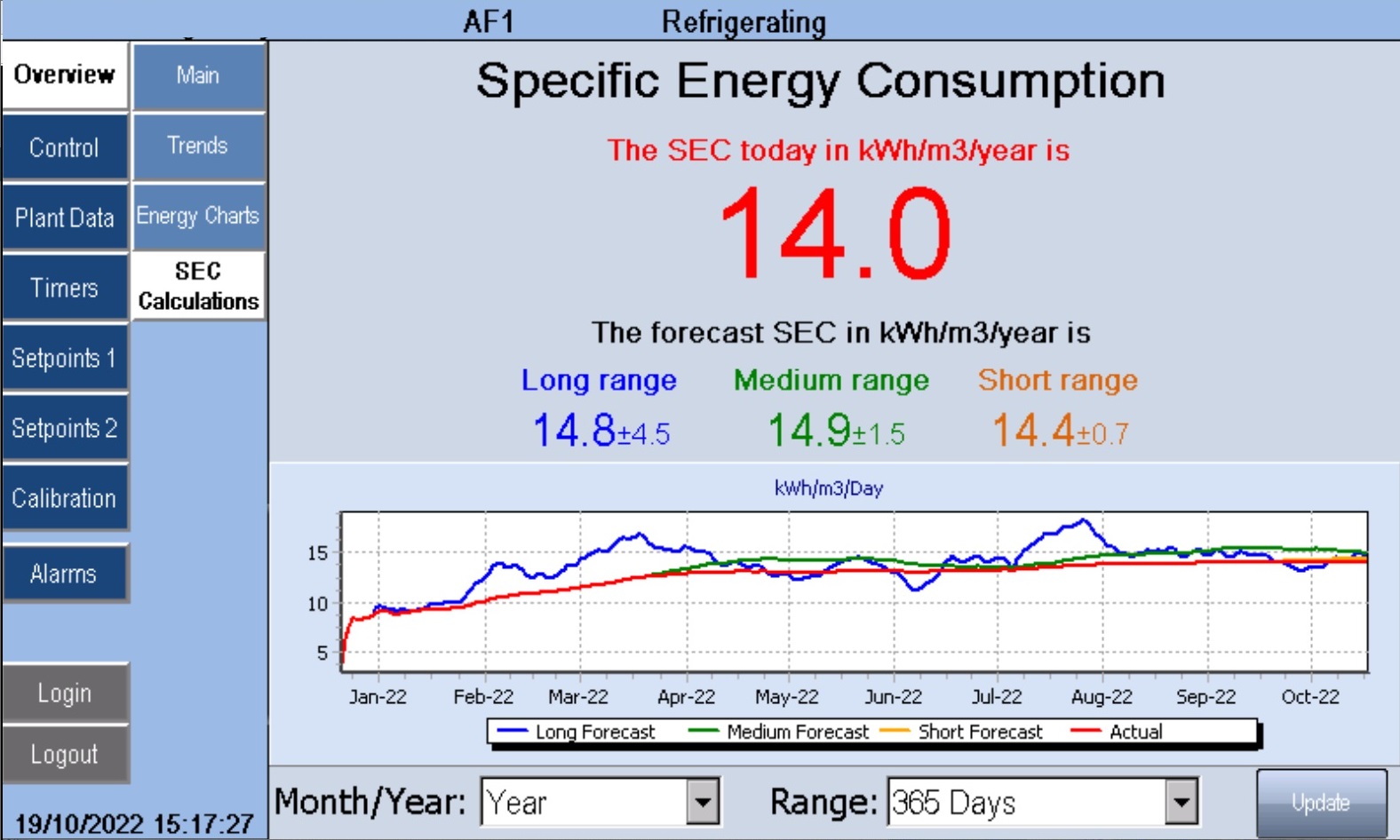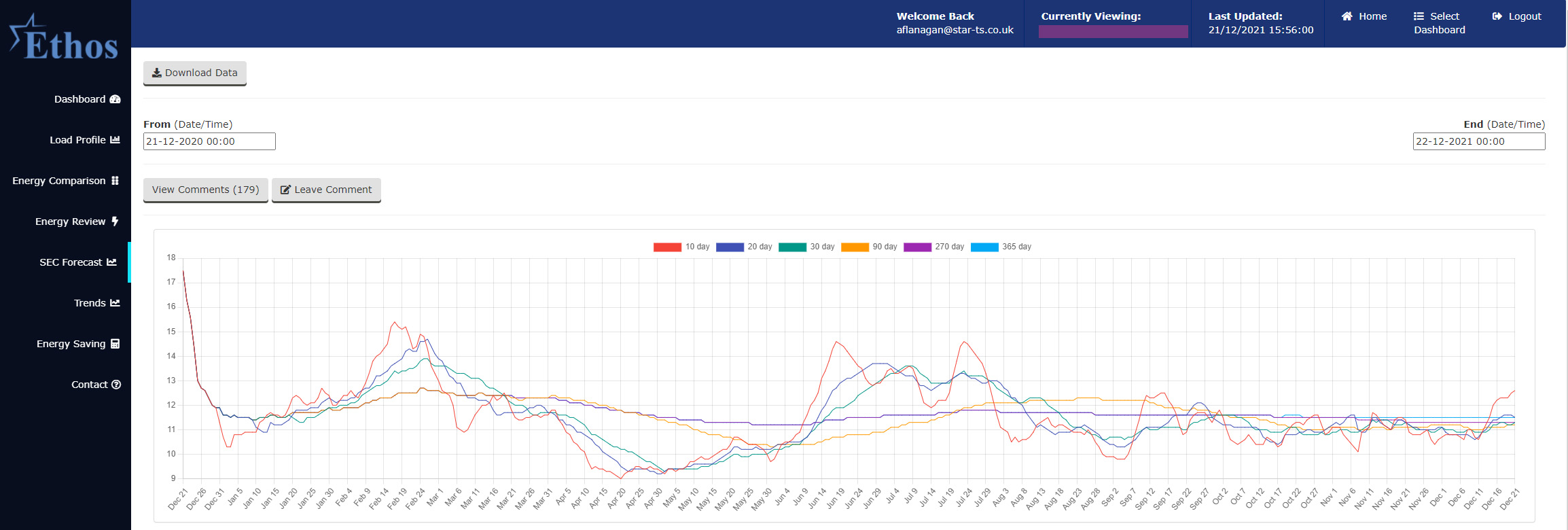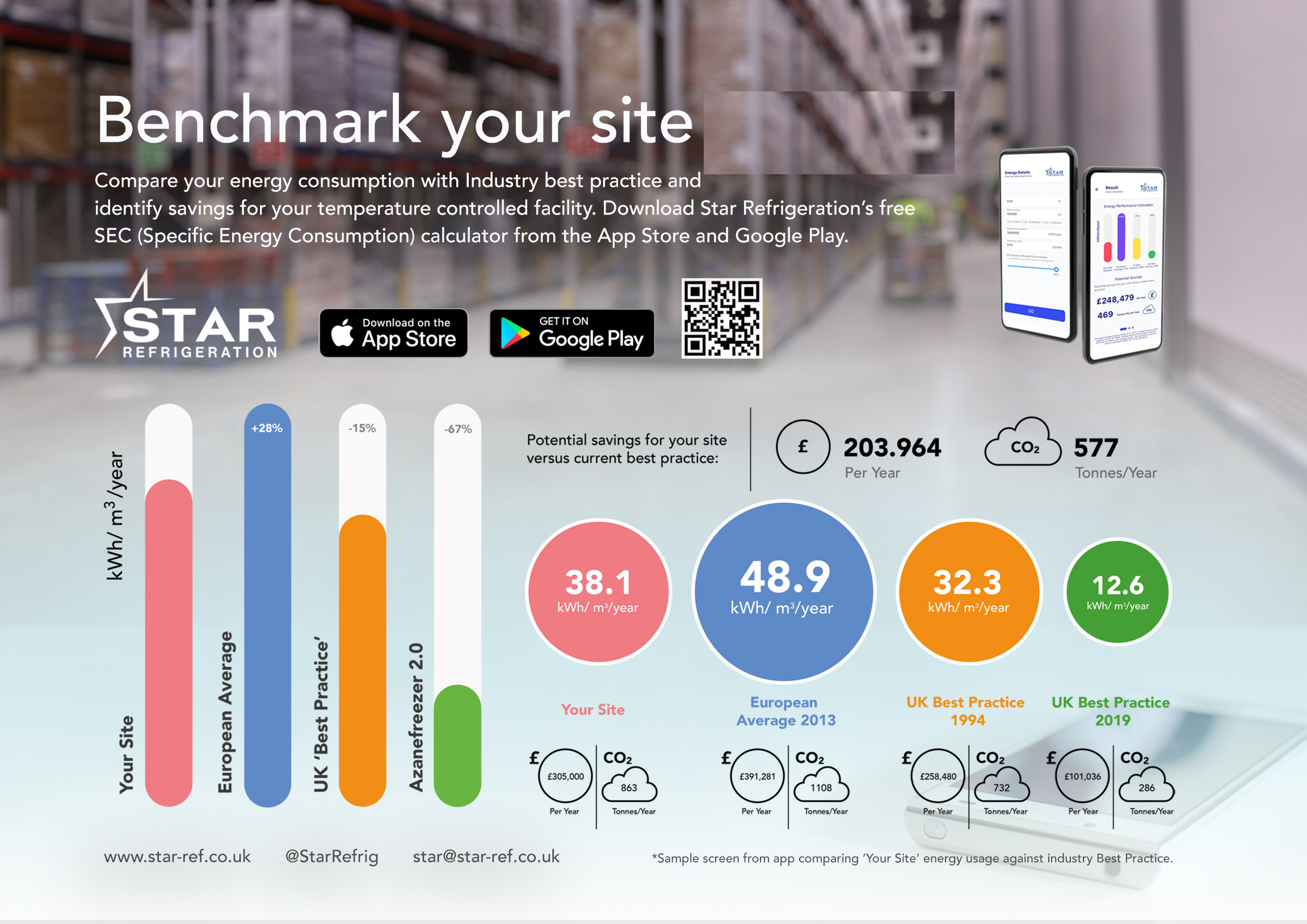Author
Dr Rob Lamb
Group Sales and Marketing Director
01332861167
rlamb@star-ref.co.uk
Sectors
Temperature Controlled Storage & Distribution
Dr Rob Lamb
Group Sales and Marketing Director
01332861167
rlamb@star-ref.co.uk
Temperature Controlled Storage & Distribution
As the refrigeration industry attempts to chart the route to Net Zero, a new energy forecasting tool harnesses data from industrial refrigeration systems to help the cold storage operators better manage energy consumption and CO2 output.
Climate Change Agreement energy efficiency targets of a 6.67% reduction by the end of 2022 are looming, and this, along with the rapid increase in energy prices and unprecedented heat waves, means that the need to reduce energy consumption and CO2 emissions is vital. Cooling presently accounts for around 10% of all CO2 emissions, but analysts from the United Nations Environmental Programme (UNEP) expect this to reach 20% by 2050, the target year for Net Zero.
In response, Star Refrigeration is using algorithms developed over a number of years of research, data monitoring and analysis to predict the energy performance of a temperature controlled storage facility 12 months in advance. This helps mitigate unexpected increases in energy consumption bills caused by alterations in daily operations.
The ability to assess the financial and efficiency impact for the coming year of changes made to operating parameters, planned maintenance work and plant enhancements can significantly reduce annual energy usage and CO2 emissions of refrigeration systems. Being able to do this in real time means operators can identify inefficiencies promptly rather than waiting for the energy cost creep to occur.
Star Refrigeration has been conducting research in the field of energy reduction of refrigeration systems in temperature controlled storage since the 1990’s. Recent research findings published from 2017 to 2022 by Dr Andy Pearson, Group MD of Star Refrigeration, not only revealed that some cold stores in the UK require up to ten times more electricity than others of similar size and throughput, but it also indicated that the energy consumption of a modern and well maintained temperature-controlled storage facility could be less than 30% of the accepted UK’s ‘Best Practice’ Guidelines figures at the time (prior to 2019).
His research also produced new energy Performance ‘Best Practice’ Guidelines for temperature controlled facilities. The new benchmark is based on a metric known as Specific Energy Consumption (SEC) which is measured in kilowatt hours per cubic metre per annum (kWh/m3/yr)).
Advances in technology and increasing digitalisation have meant that data and AI can now be used to provide deeper insight into many cooling issues. The use of this in combination with the SEC metric allows operators to drive energy optimisation and help temperature controlled storage sites make essential cost savings and CO2 reductions.

The SEC metric – What is it and how will it help?
SEC can be used to benchmark the energy performance of a chill/cold store against industry standard and also as a forecaster, letting site owners predict the future energy consumption of a site.
This can easily be done with Star Refrigeration’s free SEC Calculator App. Once downloaded via apple or google stores (onelink.to/jtaenw ), all that is required is for the user to input the store type (freezer, chill or mixed), the annual energy consumption and the volume. The price paid per unit of electricity can also be added to produce a running cost comparison.
The app will then show how the store compares against sites of similar size and throughput across the UK and Europe, and what sort of energy, CO2 emission and cost savings are possible by improving the site’s energy efficiency.
The app can also be used to benchmark a store located anywhere across the 7 continents against best practice, regardless of location, as ambient conditions are not a variable used in the calculations and therefore ‘Best Practice’ guidelines will still apply.
Effective forecasting of the refrigerated warehouse energy usage is crucial for maintaining a consistent bill at the end of the year.
The SEC Predictor predicts electricity consumption in advance, allowing for rectification and adjustment of inefficient components, ongoing service / maintenance and processes before it is too late to address increasing energy costs at the end of the year.
The submetered energy data is collected daily and predicts future performance through the use of a mathematical algorithm developed by Dr Pearson and the theoretical models automatically created by machine learning processes. Three predictions are produced (long, medium and short term) based on differing sizes of data sets and displayed along with the actual SEC figure of the cold store for the last 365 days.

Through the aforementioned computation, high accuracy data is attained, with a +-5% margin for 246 days of data, and a +- 20% accuracy for 90 days. As more information is gathered from the temperature controlled storage facility, an improvement in the tolerance level can be seen, even though just 10 days of data still provide a relatively good margin of +- 30%.
Data collected over a short-term (10-day) period, a medium-term (90-day) period and a long-term (270-day) period is tracked to show trends in energy expenditure. Understanding the full picture to control business operating costs is a balancing act. It requires the three ranges of data to be measured and compared against each other as data collected during shorter periods can expose issues rapidly and offer greater flexibility when addressing inefficiencies but lack the accuracy achieved with greater amounts of data.
These high rates of accuracy mean that plant operators and owners can gauge what the store’s energy consumption and CO2 emissions might look like if energy reductions are made by entering the kilowatt per hour changes along with a future date. If enough data is inputed, the projected outcome in terms of cost cutting and CO2 output is extremely reliable.
The SEC Predictor is now included as standard in Star’s PLC software for new installations and can also be retrofitted to existing systems. It is also available via Ethos, Star’s performance management software which allows end-users to monitor, assess and forecast energy consumption based on current cooling equipment activity, including day-to-day operations, planned maintenance activity, control changes and unpredicted events.
What affects the energy performance of a cold store?
There are five main factors impacting a building’s energy performance that can be split into two major categories – heat load, and the efficiency of the refrigeration plant.
Firstly, it is important to consider how the building uses energy – what is the utilisation of the building and how busy is it – can product throughput be measured and correlated to energy?
The weather factors in as a second element too. Humidity and the amount of sunshine will alter the building’s temperature, which in turn affects how hard a cooling system needs to work.
Thirdly, the fabric of the building – how good it is at preventing heat from getting in and what condition is the building itself ie doors, ceilings and wall insulation?
The store’s management and operators also play a key role, as keeping good door discipline and ensuring incoming product temperature is well-controlled, depends on human input.
Finally, the performance of the refrigeration plant itself – how well does the cooling system handle the heat load and how hard does it have to work to reject heat?
Whether it is the physical condition of the building or the way it is operated, the first four factors determine the size of the load while the design of the refrigeration system, based on its Coefficient of Performance (COP), defines the efficiency and performance of the plant to take account of present and future cooling load demands.
Keeping a close eye on all these factors and the influence they have in the amount of energy needed to maintain the temperature of a cold store can help businesses understand how to save energy and reduce operational costs.
Future forecasting
Efficient use of energy is crucial and is key to a temperature controlled warehouse achieving its Climate Change Agreement targets. It is not just CO2 output that it is important, energy prices are sharply rising and consumption that could be avoided by collecting and analysing daily data from the plant to promptly take remedial action could mean the difference between a profit or a loss.
Unfortunately, in too many occasions cold store operators are only aware of how much energy is used when they get their energy bill.
AI driven data monitoring systems such as Ethos offer users a key benefit. Operators do not have to wait to discover the savings that could be achieved by making adjustments, the platform predicts the likely outcome and provides accurate energy consumption forecasts. Based on the use of the predictive Specific Energy Consumption (SEC) models developed by Star Refrigeration and machine learning, Ethos can compare real-time data from the individual elements of an operational cold store with a theoretical computer generated twin to track and predict energy performance as well as recommend corrective energy improving actions. The dashboard allows users to see how much energy each individual element is using, the cost of it and the cost savings associated with acting on the energy insights.
If a plant owner adjusts the temperature by just a couple of degrees, for example, Ethos will analyse the data and return the projected outlook for the plant 95, 275 or 355 days later. The software will also ensure that the plant continues to operate correctly when testing temperature adjustments.
Having the ability to look forward like this is useful in temperature-controlled facilities where daily operation changes can substantially affect the fragile environment and have costly consequences for the business. By modelling different scenarios before adjustments to the cooling system, store’s ancillary elements and produce throughput are undertaken, management can avoid expensive errors and health hazards, as well as product wastage.
How can data help on the journey to Net Zero
Data enables informed judgements to be made about what will improve operation efficiency, reduce energy consumption and CO2 emissions.
The latest report from UNEP shows that the world is heading for a global temperature increase of 2.7 degrees by the end of this century, a figure which would cause disastrous, irreversible climate change. It is not just climate change that the cold chain must consider, paying for energy constitutes between 9-17% of a facility’s revenue and electricity costs have more than doubled in the last year.
Though not every facility will be able to reach best practice baselines for energy consumption, whether due to system requirements, building condition, or other factors, even small improvements add up. Just moving down from 20 Kilowatts to 15 an hour creates savings of 25% on energy bills, which not only reduces CO2 emissions, it positively impacts the bottom line.
It is clear the refrigeration industry needs to do more to cut power usage – 45% of cold storage plants are falling short of their CCA targets, but insight can help galvanise efficiency. The SEC Benchmarking tool and the SEC Predictor have a crucial role to play, as by benchmarking and modelling the outcome of energy reduction changes, then following up with performance, sites’ can start to get to grips with the issue of energy consumption.

The SEC Predictor comes as standard on all new Star systems, can be retrofitted to existing equipment and is also included in the company’s data monitoring system Ethos. The SEC Benchmarking Calculator can be downloaded for free on IOS and Android App stores by searching for “SEC Calculator”, while mobile browsers can download the app at onelink.to/jtaenw.
This article has been certified for Continuing Professional Development (CPD) by The CPD Certification Service. To get your CPD Certificate please email your request to CPDCertificate@star-ref.co.uk